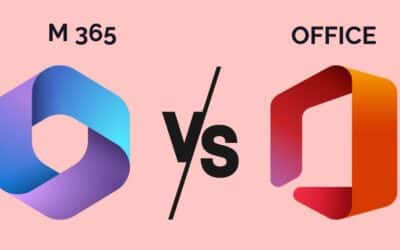With digital identities exploding and hybrid environments becoming increasingly complex, it’s clear that identity and access management (IAM) is no longer an option, but a necessity. More than just a control tool, it’s an opportunity to secure your systems and meet compliance requirements. At SmartYou, we help you to understand everything you need to know about this subject, and then determine the right solutions for your needs.

Book a free Modern Workplace diagnostic
Are your IT tools really adapted to your needs? Take advantage of a free 30-minute diagnostic to assess your current infrastructure and identify opportunities for improvement.
What is identity management?
Identity and Access Management (IAM) is a set of practices and tools designed to control and secure access to an organization’s systems, applications and data.
It ensures that only authorized people can access the appropriate resources, according to their role or needs.
In short, the right people access the right resources at the right time.
Let’s take a look at the keys to an effective identity and access management strategy.
Key components of an IAM strategy
It is based on three fundamental principles: multi-factor authentication, role and permission management, and access monitoring and auditing.

Multi-factor authentication (MFA)
Multi-factor authentication is an authentication method that adds an extra layer of security to password authentication. Indeed, it requires at least two identification factors before granting access to a system.
These factors may include :
- Something the user knows, such as a password, the answer to a secret question or a PIN code.
- Something the user owns, like a smartphone or a security key.
- Something that characterizes the user, such as biometric data (fingerprint, facial recognition).
By combining these elements, MFA significantly reduces the risk of identity theft and enhances protection against cyber-attacks.
| 💡Good to know: two-factor authentication (2FA) is a form of MFA, but limited to two different factors. In most cases, this involves a password and a secret code sent by SMS or e-mail. |
Managing roles and permissions
It is based on the principle of least privilege: this is both a concept and a practice in IT security, whereby each user is granted only those rights strictly necessary for his or her functions.
The principle of least privilege is one of the pillars of the security model Zero Trust security model, which requires all users to be authenticated, authorized and continuously validated.
| 💡Good to know: companies used to apply the “trust, but verify” approach. The Zero Trust model is based on the opposite principle: “Never trust, always verify”. |
Best practices for managing roles and permissions include :
- Clearly defined roles within the organization.
- The use of groups to simplify the allocation of permissions.
- Regular access reviews to detect and remove obsolete rights.
This step-by-step control limits the impact of a potential security breach or human error.
Access monitoring and auditing
An IAM system cannot be effective without continuous monitoring and a precise overview of access management.
The monitoring tools, of which we will give a few examples below, offer :
- Real-time alerts on abnormal behavior or unauthorized access attempts,
- Detailed logs of connections, resources used and actions performed.
- The use of artificial intelligence or detection models to identify potentially malicious activities or anomalies.
Audits involve a detailed analysis of identity and access management processes in order to :
- Check that your company complies with standards and regulations, such as nLPD, ISO 27001, or SOX.
- Identify loopholes.
- Optimize processes.
Audits can use monitoring tools to collect and analyze historical data. An audit can be carried out in-house or delegated to an external external service provider.

Book a free Modern Workplace diagnostic
Are your IT tools really adapted to your needs? Take advantage of a free 30-minute diagnostic to assess your current infrastructure and identify opportunities for improvement.
The benefits of identity management
Among all the advantages of IAM, here are three that we feel are particularly important to highlight.
Improving the security of sensitive data
This is undoubtedly the main objective of any company that sets out to define an identity management policy: to protect its critical information.
And with good reason: according to a report by the Ponemon Institute in collaboration with IBM, 90% of security breaches are caused by human error.
Fortunately, identity management limits the risks associated with human error and unauthorized access, which are often at the root of security breaches. The likelihood of unauthorized users gaining access to the network, whether deliberate or accidental, is reduced. IAM limits the risk of theft of sensitive data, as well as the risk of data loss due to mishandling.
Simplifying the user experience
At first glance, methods such as multi-factor authentication (MFA) may seem cumbersome and time-consuming for the user. And yet, IAM is designed to simplify the user experience.
Firstly, access is centralized with Single Sign-On (SSO). This means that the user only needs to authenticate once for several applications. No need to memorize multiple passwords or go through several authentication steps for each application.
IAM then automatically assigns the appropriate permissions according to the user’s role or needs, eliminating the need to go back and forth with the IT department to adjust access.
What’s more, IAM tools can integrate password-free authentication methods, eliminating the need to memorize passwords.
Finally, IAM reduces login incidents (such as blocked accounts or forgotten passwords) thanks to automated account recovery and preventive alerts in the event of suspicious activity.
It’s also worth noting that IAM guarantees a seamless user experience, whether working from a computer, a smartphone or remotely.
Reduce compliance risks
Compliance means respecting official guidelines designed to protect sensitive data and ensure secure practices.
For example, the banking and healthcare sectors are subject to strict regulations, given the sensitive information they handle.
That said, all Swiss companies, including SMES have to comply with directives such as the new Data Protection Act. This requires that the personal data of employees, customers or partners be collected, processed and stored securely.
Thus, an IAM system plays a key role in complying with these regulations, by :
- Controlling access to sensitive data,
- Guaranteeing traceability of actions,
- Preventing data leakage.
💡Good to know: access tracking is legal, as long as companies collect only the data required for legitimate and proportionate purposes, which is the case with an identity management policy. Companies must inform employees that data is being collected (with IT charters, for example) and explain why. In doubt? SmartYou answers all your questions.

How do you set up effective identity management?
Implementing an effective IAM strategy requires methodical planning and execution.
Assess your identity management needs
The first step is to understand your identity and access management requirements.
First, ask yourself what your major problem is. Once you’ve identified it, you then have your main objective, which you translate into a metric. For example, if your challenge is onboarding the metric could be the average time it takes to grant access to a new employee.
Next, take stock of current access rights, for example by means of a table listing each user, their role, rights and real needs. This will enable you to quickly identify unnecessary access and lay the foundations for management based on the principle of least privilege.
Finally, take a look at your technological environment. Take stock of your existing tools (e.g. LDAP directory, Active Directory, cloud solutions, SSO tools, etc.) and manual processes. Are there any repetitive processes that could be automated with an IAM solution?
Choosing the right IAM tools
Once your needs have been defined, it’s essential to select the tools that will meet your objectives. And there are plenty of IAM solutions to choose from! Okta, Microsoft Entra Domain Services, Ping Identity, IBM Verify…
Not all IAM tools are suitable for all contexts. For example:
- CyberArk specializes in Privileged Access Management (PAM) for sensitive accounts.
- Microsoft Entra Domain Services is often preferred in environments already using Microsoft tools.
- JumpCloud, OneLogin and SecureAuth are specially designed for the needs of SMEs.
So you need to compare them according to specific criteria:
- Functionality (SSO, MFA, role management, access analysis, etc.)
- Compatibility with your existing systems and applications.
- The ability to adapt to your company’s growth.
- Simple integration
- The budget, of course.
Train IT teams and users
We can’t stress this enough: technology alone is not enough. User awareness and IT team preparation are fundamental.
The key steps to successful adoption therefore include :
- Training IT teams to configure and administer the IAM solution, manage roles and permissions, and monitor suspicious activity.
- Raising user awareness to explain IAM-related best practices, such as the importance of activating MFA, securing credentials, and respecting access policies. Find out more in our article on cybersecurity awareness.
- Setting up support with user guides, a dedicated team to answer questions, and follow-up on problems encountered during the transition.

Common identity management problems and solutions
At SmartYou, we’ve observed three common problems.
Remote and hybrid user management
Teleworking has seen an unprecedented rise in Switzerland in recent years, as a study by the Swiss Federal Statistical Office shows. The hybrid model, combining telecommuting and on-site work, has become commonplace.
As a direct consequence, companies have to manage :
- A growing number of digital identities, as every employee and every appearance becomes an identity to be managed and secured;
- Secure access from uncontrolled environments, such as an employee’s personal Wifi or public Wifi;
- The management of their employees’ personal devices (Mobile device management), whose use complicates the protection of sensitive data and compliance with security policies.
This is where digital identity and access management comes into its own. It enables users to be managed centrally, connections to be secured and policies adapted to hybrid environments to be established.
Integration of heterogeneous systems
The second problem is that many companies use a mix of on-premise, cloud and third-party systems that are not always designed to work together. This heterogeneity complicates identity management and increases security risks.
To overcome these obstacles, we recommend :
- Choose IAM tools that can integrate with a wide range of systems, via APIs or native connectors, to centralize identity and access management.
- Use protocols such as SAML, OAuth or OpenID Connect, which simplify interoperability between different systems and IAM tools.
- Implement a solution capable of federating identities across multiple systems.
Minimize unnecessary access and excessive privileges
As you may have gathered, this involves applying the Zero Trust strategy we mentioned earlier, in particular the principle of least privilege.
Regular audits of access rights enable obsolete or inappropriate authorizations to be identified and revoked.
In addition, the implementation of a control for each access request ensures that each access request is validated before being activated.
We also recommend using IAM tools capable ofautomatically assigning and revoking permissions based on roles, projects or employee departures, such as Okta, Microsoft Entra Domain Services, SailPoint IdentityNow or One Identity, to name but a few.
SmartYou supports your IAM strategy
At SmartYou, we help you design and deploy an identity and access management strategy tailored to your company’s specific needs. Thanks to our expertise, we can simplify access management while strengthening the security of your systems.

Book a free Modern Workplace diagnostic
Are your IT tools really adapted to your needs? Take advantage of a free 30-minute diagnostic to assess your current infrastructure and identify opportunities for improvement.
First, our experts start with a complete audit of your environment to identify your IAM priorities and challenges.
We then provide you with a clear analysis of the most suitable solutions, whether you need to integrate multi-factor authentication, streamline role management, or set up advanced monitoring tools.
Once the solution has been defined, we draw up a customized implementation plan. We ensure that your new IAM strategy integrates seamlessly with your existing processes, while minimizing disruption to your teams and guaranteeing a high level of security.
Ready to secure and simplify your identity management?
With SmartYou, you benefit from personalized support for more efficient, secure identity management, in line with your company’s strategic objectives.
Contact us to find out more!
In conclusion, identity management is much more than a technical issue, it’s an integral part of your IT policy. Ready to make IAM an asset for your company? Contact our experts today.




